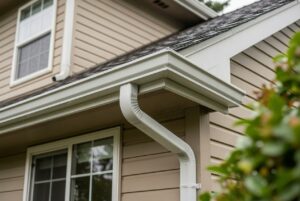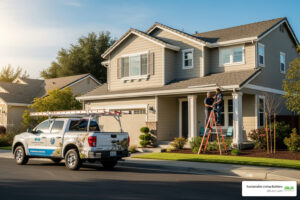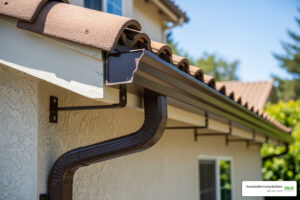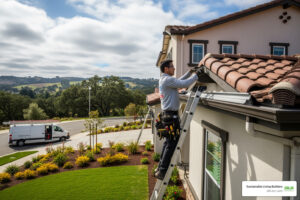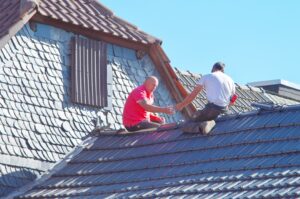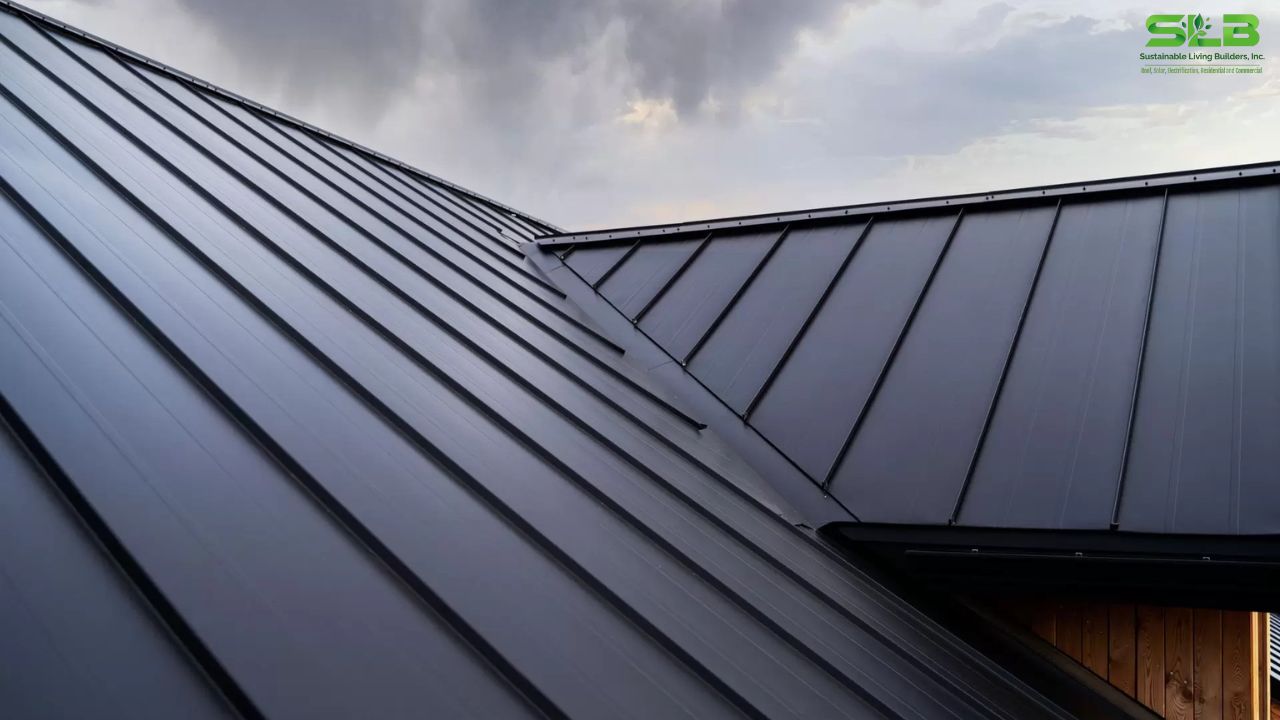
Gutter Roof Flashing Explained: Purpose, Types & Installation
Boosts Energy Efficiency: Flashing helps maintain better insulation by preventing water from seeping into the roof structure, which can improve energy efficiency.
Reduces Maintenance Costs: A well-installed gutter roof flashing can significantly reduce the need for costly roof repairs by protecting vulnerable areas from water damage.
Enhances Aesthetic Appeal: Flashing can add a neat, finished look to roof edges, blending functionality with design for a polished appearance.
Water is one of the vital components for life. However, it can also be one of the biggest threats to your home. If it’s not directed away properly, it can cause wood rot, mold, and even structural damage to your house.
This is where gutter roof flashing comes in. A flashing between gutter and roof is a small detail on your roof, but it plays a big role in protecting your house.
In this article, you’ll learn what gutter flashing is, why it’s important, the different types, and how it’s installed—especially for homes in the U.S.
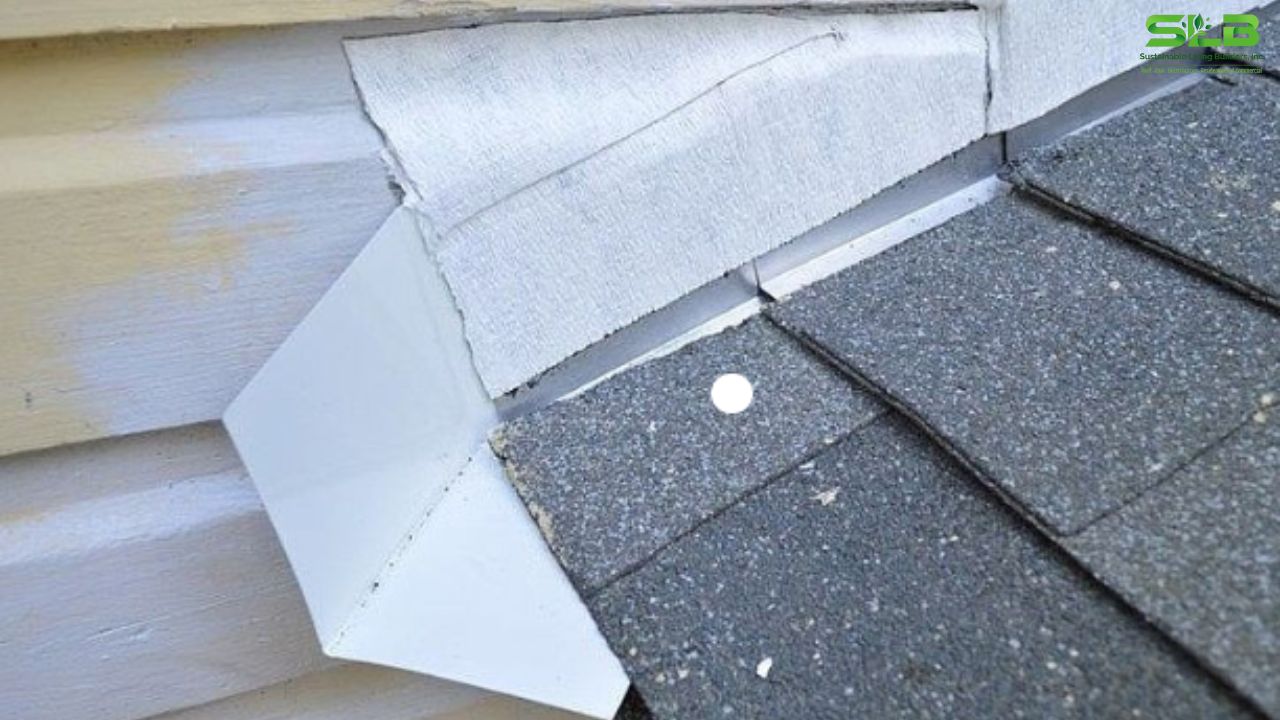
What Is Gutter Roof Flashing?
Gutter roof flashing is a thin piece of metal that fits between your roof and gutter. It helps water flow off the roof and into the gutter, so it doesn’t get behind the gutter and damage your home.
Without flashing, water can sneak behind the gutter and soak the wooden parts of your house like the fascia board. Over time, that can lead to rot and expensive repairs.
Why Does Gutter Flashing Matter?
While flashing might be small, it’s very important to protect the structure of your home. Here are the main reasons why it matters:
- Stops water from leaking behind gutters
- Protects wood trim and fascia from rot
- Prevents mold and mildew
- Helps extend the life of your roof and gutters
In many U.S. states, building codes now require gutter flashing, especially drip edge flashing, to be installed when you get a new roof.
Where Is Gutter Flashing Installed?
Flashing is installed at the edge of the roof, just above the gutter. It slips under the bottom row of shingles and hangs slightly over or inside the back edge of the gutter. That way, water flows from the roof into the gutter without touching any wooden parts.
Common Types of Gutter Flashing
There are a few common flashing styles that are used along the roof and gutter edge for homes. Here are the most common types for U.S. homes:
Drip Edge Flashing
A thin metal strip that sits under the shingles and over the roof edge. It directs water straight into the gutter. This type of flashing is required by code in many states.
Gutter Apron Flashing
This is larger than a drip edge and curves to cover more of the fascia. It is a good choice for older homes or homes with steep roofs. It also handles heavy rain better.
Kickout Flashing
This flashing is placed where the roof edge meets a wall. It redirects water away from the wall and siding to prevent leaks and water damage inside the home.
End Cap Flashing
This flashing between gutter and roof covers the ends of gutters to stop water from leaking out the sides.
Best Materials for U.S. Homes
Flashing comes in a few different materials with each having its own pros and cons. Common flashing materials include:
Aluminum
This is the most common flashing material in U.S. homes. It is lightweight, rust-resistant, easy to cut and install, and budget-friendly.
Galvanized Steel
This material is strong and durable but may rust if the coating wears off. It’s often used with a protective paint or finish.
Copper
Copper flashing is long-lasting and weatherproof. It is often used on historic or high-end homes and adds a decorative touch. It’s more expensive than other materials.
Vinyl or PVC
Vinyl is not commonly used for flashing but may be found in DIY repairs. It is less durable and not ideal for places with extreme weather.
Do You Need Gutter Flashing?
Many older homes were built without flashing. If you’re not sure whether your roof has flashing, look for these signs:
- Water stains or peeling paint near the roof edge
- Rotting or soft wood near your gutters
- Mold or mildew on siding near the gutters
- Water dripping behind the gutter during rain
- Gutters pulling away from the roof
If you notice any of these signs, it’s a good idea to check the flashing or install new flashing if it’s missing.
Gutter Flashing Installation: Step-by-Step
You can install gutter flashing yourself if you’re comfortable working on a ladder. If not, it’s best to hire a licensed roofer. Here’s a step-by-step look at how it’s usually done.
Tools and Materials Needed
Flashing (drip edge or gutter apron), tin snips, roofing nails or screws, hammer or drill, tape measure, ladder, roofing sealant (optional), work gloves and safety glasses
Installation Steps
- Lift the bottom row of shingles. Carefully lift the first row of shingles near the edge of the roof.
- Cut the flashing. Use tin snips to cut each piece of flashing to the length of the roof edge.
- Slide flashing under shingles. Place the top edge under the shingles and let the bottom hang inside or slightly over the gutter.
- Nail it down. Secure the flashing to the roof deck using nails or screws, spaced about 8 to 12 inches apart.
- Overlap pieces. If you’re installing multiple pieces, overlap them by at least 2 inches.
- Seal gaps. Use roofing sealant if needed to close any joints or gaps.
Always use proper safety equipment when working on a roof.
Cost of Gutter Flashing in the U.S.
The cost of gutter flashing depends on the material, the size of your roof, and whether you install it yourself or hire a pro.
Material Costs (Per Linear Foot)
Flashing Material | Estimated Cost |
Aluminum | $0.50 – $1.00 |
Gutter Apron | $1.00 – $2.50 |
Galvanized Steel | $1.50 – $3.00 |
Copper | $5.00 – $10.00 |
Labor Costs
If you hire a contractor, labor usually adds up to:
- $2.00 to $5.00 per linear foot, or
- $150 to $500 total
Prices can vary based on location and time of year. Also, it majorly depends on your roof size as well.
Maintenance Tips for Homeowners
Once installed, gutter roof flashing needs minimal, but necessary care. It’s advisable to:
- Clean your gutters twice a year, in spring and fall
- Inspect the flashing during routine roof checks
- Check for damage after big storms
- Trim tree branches to reduce debris
These simple steps can help your flashing last longer and keep your roof protected.
Gutter Apron vs. Drip Edge: Which Should You Choose?
Both options help direct water into your gutters, but there are a few key differences.
- Drip edge is slimmer and is now required by most U.S. building codes.
- Gutter aprons provide more coverage and are a good fit for steep or older roofs.
Some homeowners even use both for extra protection.
Final Thoughts
Gutter roof flashing may be small, but it does a big job. It keeps water away from your home’s structure, prevents costly damage, and extends the life of your roof and gutters.
If you’re installing a new roof or upgrading your gutters, make sure to include flashing in your plan. If your home doesn’t have it, it’s never too late to add.
Taking the time to install flashing now can save you thousands of dollars in future repairs. Whether you do it yourself or hire a roofing pro, it’s a smart move for any homeowner.
Sustainable Living Builders is a company that supports sustainability through green living solutions, including all types of roofing and gutter services.
Offering a free estimate within 48 hours, Slb Inc. offers the best sustainable solutions for residential and commercial projects in the regions of Sonoma, Marin, and Napa counties in California.
Related Articles You May Like
✔️ Why a Solar Roof Tesla Is the Perfect Year-End Upgrade
✔️ Roofing
✔️ Roofing Contractor
✔️ Affordable Roofing Services
✔️ Emergency Roofing: What to Do When Disaster Strikes
MULTIPLE SERVICES, EVEN MORE SUSTAINABLE SOLUTIONS!
If you’re looking for a team of experienced, hard-working, and committed team to take your home or business to a more sustainable future, Sustainable Living Builders, Inc. is here for you! From holistic roofing solutions to innovative solar options, we have many services to help you protect your home and your pocket in a single place. Are you ready to get started?

